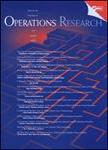版权所有:内蒙古大学图书馆 技术提供:维普资讯• 智图
内蒙古自治区呼和浩特市赛罕区大学西街235号 邮编: 010021

作者机构:Univ Illinois Dept Agr & Consumer Econ Urbana IL 61801 USA Napier Univ Sch Life Sci Edinburgh EH10 5DT Midlothian Scotland
出 版 物:《OPERATIONS RESEARCH》 (运筹学)
年 卷 期:2006年第54卷第2期
页 面:379-388页
核心收录:
学科分类:1201[管理学-管理科学与工程(可授管理学、工学学位)] 07[理学] 070104[理学-应用数学] 0701[理学-数学]
主 题:PROGRAMMING APPROACH SITE SELECTION MOVEMENT CORRIDORS LOCATION PROBLEM CONSERVATION ALGORITHMS LANDSCAPE HABITAT BIRDS OPTIMIZATION
摘 要:Spatial considerations are important in conservation reserve design. A particularly important spatial requirement is the connectivity of selected sites. Direct connections between reserve sites increase the likelihood of species persistence by allowing dispersal and colonization of other areas within the network without species having to leave the reserve. The conventional set-covering and maximal-covering formulations of the reserve selection problem assume that species representation is the only criterion in site selection. This approach usually results in a small but highly fragmented reserve, which may not be desirable. We present a linear integer programming framework incorporating spatial contiguity as an additional site selection criterion. An empirical application to a data set on the occurrence of breeding birds in Berkshire, United Kingdom, demonstrates that site connectivity requires a significantly larger reserve. Incorporation of spatial criteria increases the computational complexity of the problem. To overcome this, we use a two-stage procedure where the original sites are aggregated first and an optimum solution is determined for the aggregate sites. Then, site selection is restricted to original sites included in the aggregate solution and a connected reserve is determined. In this particular application the above procedure generated a significantly more efficient reserve than a heuristic selection.